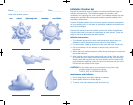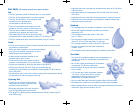
Fun Facts (all measurements are approximate)
Sun
• The Sun provides warmth to Earth’s land, air, and oceans.
• The Sun is the largest object in our solar system.
• The Sun has six layers: core, radiation zone,
convection zone, photosphere,
chromosphere, and the corona.
• The Sun’s gravitational pull keeps all of the
planets in our solar system in orbit around it.
• The Sun emits radiation including: radio waves,
ultraviolet rays, gamma rays and x-rays.
• The hottest part of the Sun is at the core with
temperatures that reach around 27 million°F (15 million°C.)
• The Sun rotates and spins around once about every 27.4 days.
Cloud
• Clouds are formed by millions of water droplets that have risen into the
sky and then cooled down.
• When the water droplets in a cloud become heavy
they fall to the surface causing rain or snow
depending on the temperature.
• It takes clouds anywhere between a few
minutes and an hour to form.
• There are ten basic cloud types including:
cumulus, cumulonimbus, cirrus, and stratus.
• Clouds are classified by how high the base of the cloud is.
• Clouds are moved by the wind. High cirrus clouds that get
pushed by the jet stream can sometimes reach speeds of 100 miles per
hour (160 km/h).
• Clouds reflect some of the Sun’s heat causing cooler temperatures during
the day when clouds are present in the sky.
Lightning Bolt
• Lightning is an electric discharge that
can jump from cloud to cloud and also
between clouds and Earth.
• Everyday throughout the world, there are
over 100 lightning strikes per second.
• The length of a lightning bolt averages between 2 and 6 miles long (3.2
and 9.6km long).
• Lightning that occurs at night can sometimes be seen up to 100 miles
(160 km) away.
• Lightning bolts have a temperature that is hotter than the surface
of the Sun.
• Lightning will occur most often at the beginning or ending of a storm.
• Lightning is the most common and dangerous weather hazard that
people encounter each year.
Raindrop
• The average size of a raindrop is between .1mm and 5mm.
• One of the biggest raindrops recorded was in Brazil
measuring 1cm.
• The average raindrop falls about 7 miles per
hour (11 km/h).
• The heaviest average rainfall in the world is in India
where 87’ (27 m) of rain has fallen in one year.
• The average rainfall for Earth is about 33" (850 mm).
• To date, no rainfall has ever been recorded in
Calama, Chile.
• The umbrella was invented originally for shade from the Sun.
Snowflake
• The sizes of snowflakes depend on the temperature it is
outside; the colder the temperature, the smaller the
snowflakes.
• One of the largest snowflakes fell in Montana;
it measured 15" (38 cm) in diameter.
• Most scientists will agree that every snowflake
has six sides.
• 10" of snow can contain anywhere between
.10" and 4" (.25 cm and 10 cm) of water
depending on different factors such as
temperature and crystal structure.
• Snow is white because the snow crystals reflect visible sunlight.
• Snowflakes are made from ice crystals that have joined together.
• When sunlight hits the snow it does not always melt because the snow
reflects the light and rays bounce off of it.
1803 InflatWeatherSetGUD RVMP2:1803 InflatableWeatherSet GUD 2/22/10 3:23 PM Page 4






